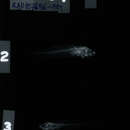Diagnostic Description
provided by Fishbase
Common amongst Dactyloscopidae: Small, elongate fishes. Head usually broad and deep, body tapering and compressed behind. Eyes on top of head, often protrusible; mouth moderate to large, oblique to vertical; jaw teeth minute, in 2 or more series; no teeth on roof of mouth (vomer and palatines). Opercular opening large, gill membrane free from isthmus; opercles membranous, large, usually overlapping on underside of head, typically fringed above with 2 to 24 fleshy fimbriae. Dorsal fin continuous, with an isolated or semi-isolated anterior finlet, or with 1 to 5 separate anterior rays; dorsal-fin spines 7 to 23; anal-fin spines 2; dorsal and anal fins free or united to caudal fin by fragile membranes; pectoral fins broad-based, usually enlarged in mature males; caudal-fin rays simple or branched; pelvic fins under throat (insertion anterior to pectoral-fin base), with 1 spine and 3 thickened segmented rays; all other rays simple. Head and venter naked, body elsewhere with large cycloid scales (smooth to touch); lateral line high anteriorly, deflecting ventrally behind pectoral fin to continue along middle of side to caudal-fin base where terminal lateral-line scale bears ventrally directed canal. Body coloration, variably pale to strongly pigmented with white, brown, or reddish; some forms with characteristic saddle-like bars crossing back; others plain, mottled, or with indications of lateral stripes. Species distinguished by: dorsal-fin origin on nape; fin with an isolated or semi-isolated anterior finlet. Segmented caudal-fin rays usually 10; arched lateral-line scales 22 to 33. First preopercular canal not branched, with a single distal pore. Upper lip without fimbriae (Ref.52855).
Morphology
provided by Fishbase
Dorsal spines (total): 1115; Dorsal soft rays (total): 2729; Analspines: 2
Trophic Strategy
provided by Fishbase
Burrows in soft sandy bottom, where it waits for prey, with only the eyes, nose and mouth protruding.
- Recorder
- Grace Tolentino Pablico
Biology
provided by Fishbase
Burrows in soft sandy bottom, where it waits for prey, with only the eyes, nose and mouth protruding.
Gillellus healae: Brief Summary
provided by wikipedia EN
Gillellus healae, the masked stargazer, is a species of sand stargazer native to the Atlantic and Gulf coasts of the United States from South Carolina to the Florida Keys as well as around Aruba where it can be found on sandy bottoms at depths of from 21 to 37 metres (69 to 121 ft). It is an ambush predator, burying itself nearly completely in the sand and waiting for prey to happen by. This species can reach a length of 7.5 centimetres (3.0 in) TL. The specific name honours Elizabeth Heal who was Technical Secretary at the Gulf Coast Research Laboratory in Ocean Springs, Mississippi.
- license
- cc-by-sa-3.0
- copyright
- Wikipedia authors and editors

